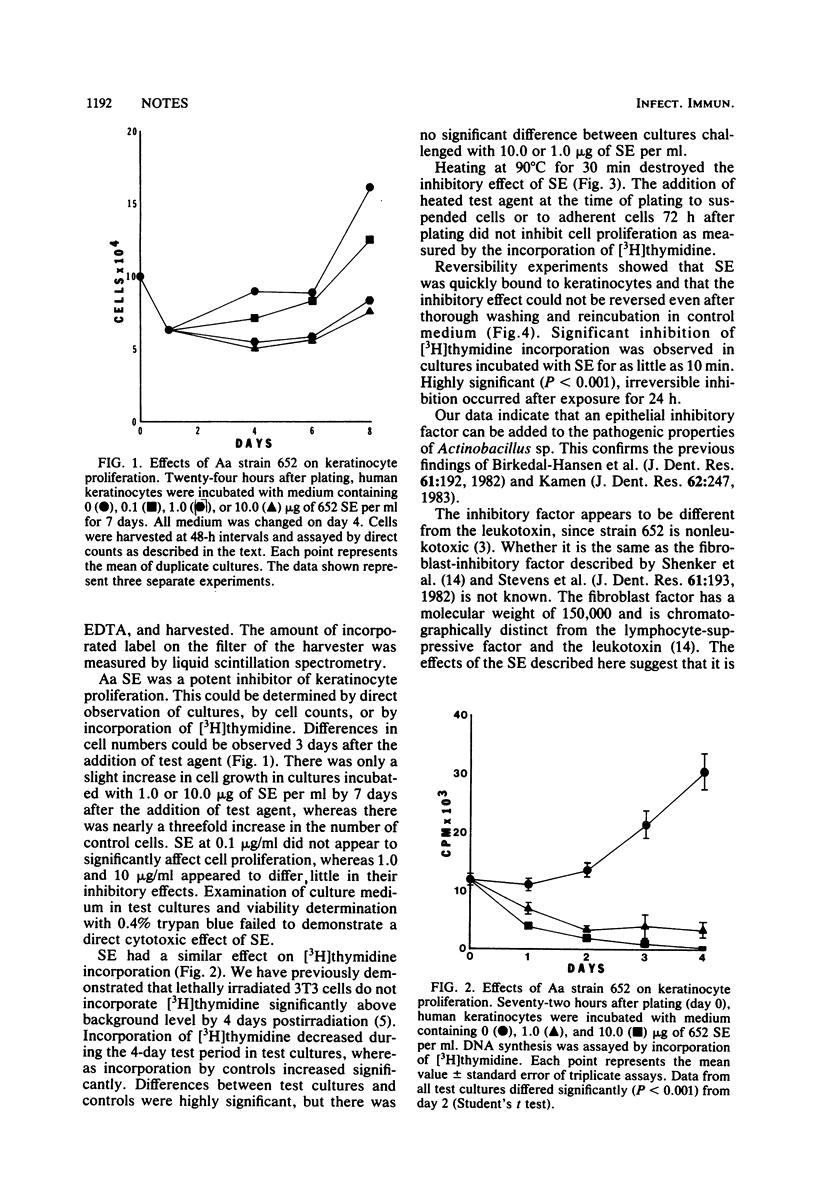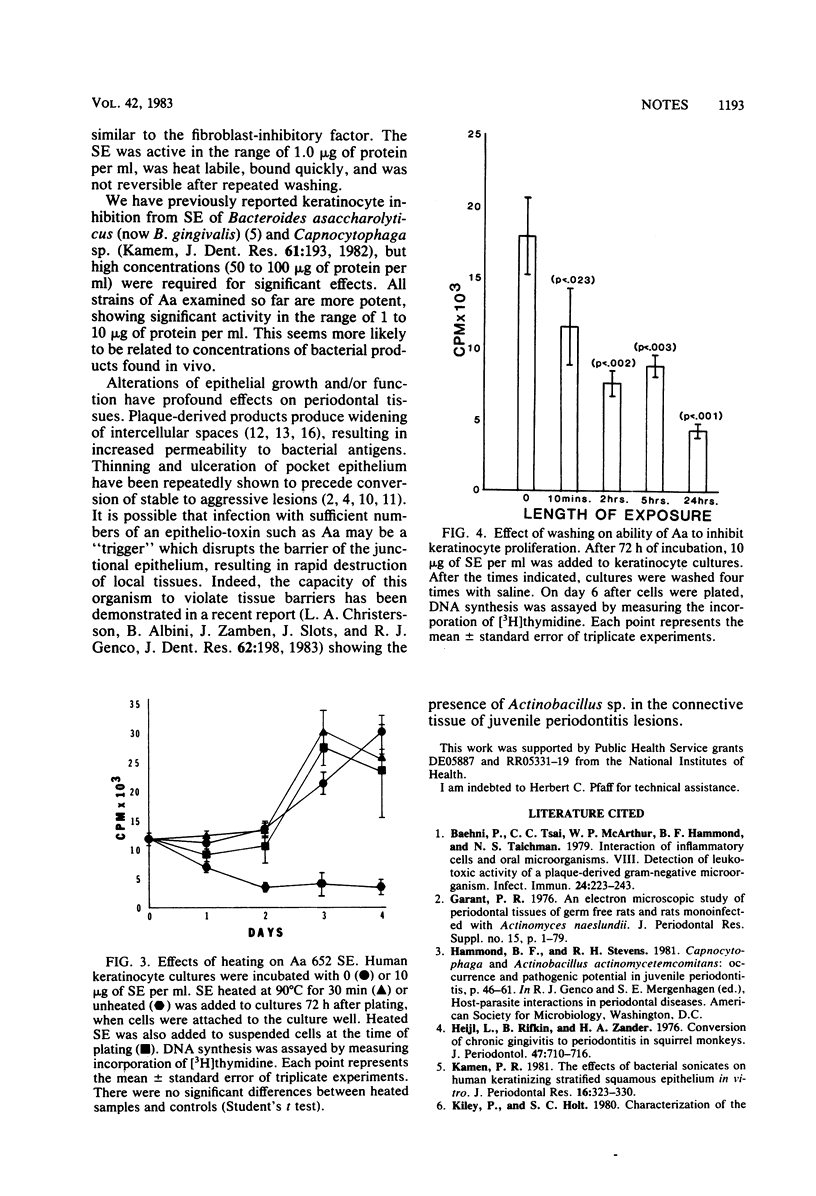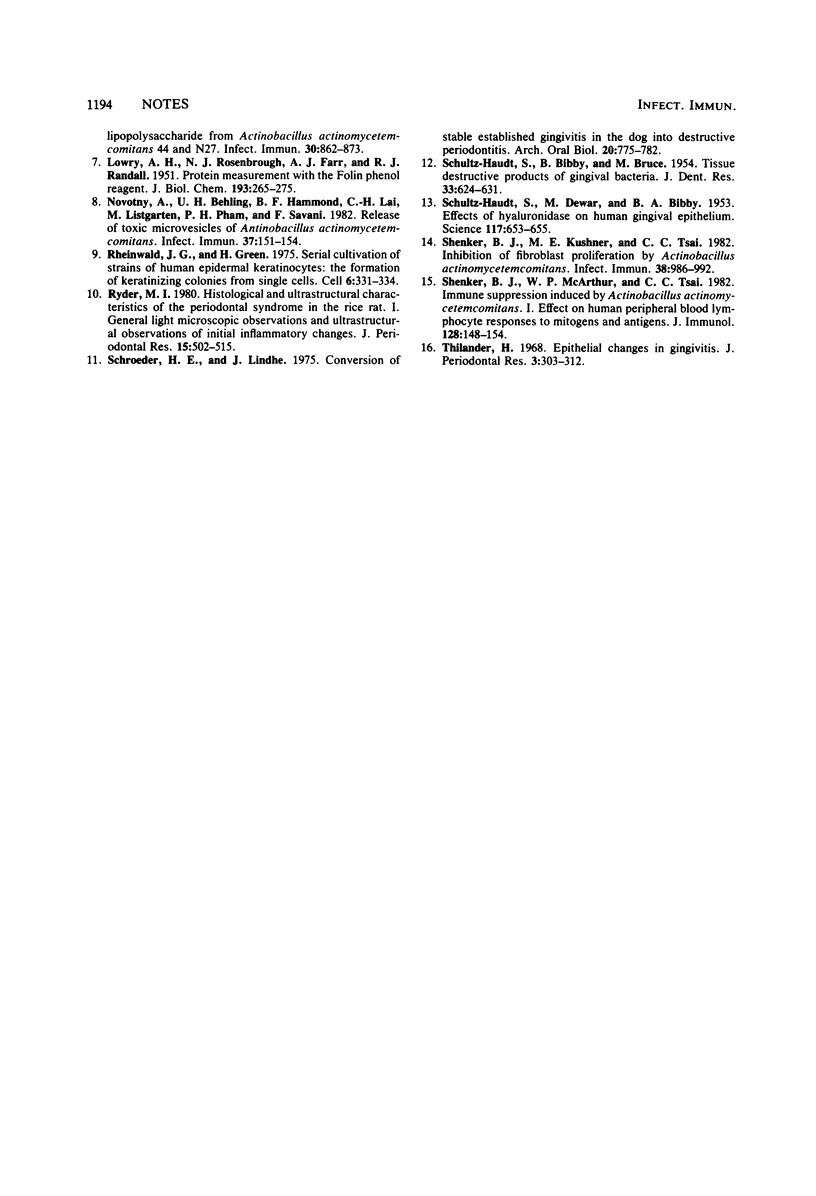Abstract
A heat-labile sonic extract of a nonleukotoxic strain of Actinobacillus actinomycetemcomitans caused a dose-dependent inhibition of proliferation of human keratinocytes. Exposure of cells to heat-labile sonic extract for periods as brief as 10 min produced significant suppression of [3H]thymidine uptake 72 h later. I propose that alteration of epithelial barriers may be one pathogenic mechanism of this organism.
Full text
PDF



Selected References
These references are in PubMed. This may not be the complete list of references from this article.
- Baehni P., Tsai C. C., McArthur W. P., Hammond B. F., Taichman N. S. Interaction of inflammatory cells and oral microorganisms. VIII. Detection of leukotoxic activity of a plaque-derived gram-negative microorganism. Infect Immun. 1979 Apr;24(1):233–243. doi: 10.1128/iai.24.1.233-243.1979. [DOI] [PMC free article] [PubMed] [Google Scholar]
- Heijl L., Rifkin B. R., Zander H. A. Conversion of chronic gingivitis to periodontitis in squirrel monkeys. J Periodontol. 1976 Dec;47(12):710–716. doi: 10.1902/jop.1976.47.12.710. [DOI] [PubMed] [Google Scholar]
- Kamen P. R. The effects of bacterial sonicates on human keratinizing stratified squamous epithelium in vitro. J Periodontal Res. 1981 May;16(3):323–330. doi: 10.1111/j.1600-0765.1981.tb00981.x. [DOI] [PubMed] [Google Scholar]
- LOWRY O. H., ROSEBROUGH N. J., FARR A. L., RANDALL R. J. Protein measurement with the Folin phenol reagent. J Biol Chem. 1951 Nov;193(1):265–275. [PubMed] [Google Scholar]
- Nowotny A., Behling U. H., Hammond B., Lai C. H., Listgarten M., Pham P. H., Sanavi F. Release of toxic microvesicles by Actinobacillus actinomycetemcomitans. Infect Immun. 1982 Jul;37(1):151–154. doi: 10.1128/iai.37.1.151-154.1982. [DOI] [PMC free article] [PubMed] [Google Scholar]
- Rheinwald J. G., Green H. Serial cultivation of strains of human epidermal keratinocytes: the formation of keratinizing colonies from single cells. Cell. 1975 Nov;6(3):331–343. doi: 10.1016/s0092-8674(75)80001-8. [DOI] [PubMed] [Google Scholar]
- Ryder M. I. Histological and ultrastructural characteristics of the periodontal syndrome in the rice rat. I. General light microscopic observations and ultrastructural observations of initial inflammatory changes. J Periodontal Res. 1980 Sep;15(5):502–515. doi: 10.1111/j.1600-0765.1980.tb00308.x. [DOI] [PubMed] [Google Scholar]
- SCHULTZ-HAUDT S., BIBBY B. G., BRUCE M. A. Tissue-destructive products of gingival bacteria from nonspecific gingivitis. J Dent Res. 1954 Oct;33(5):624–631. doi: 10.1177/00220345540330050601. [DOI] [PubMed] [Google Scholar]
- SCHULTZ-HAUDT S., DEWAR M., BIBBY B. G. Effects of hyaluronidase on human gingival epithelium. Science. 1953 Jun 12;117(3050):653–655. doi: 10.1126/science.117.3050.653. [DOI] [PubMed] [Google Scholar]
- Schroeder H. E., Lindhe J. Conversion of stable established gingivitis in the dog into destructive periodontitis. Arch Oral Biol. 1975 Dec;20(12):775–782. doi: 10.1016/0003-9969(75)90052-7. [DOI] [PubMed] [Google Scholar]
- Shenker B. J., Kushner M. E., Tsai C. C. Inhibition of fibroblast proliferation by Actinobacillus actinomycetemcomitans. Infect Immun. 1982 Dec;38(3):986–992. doi: 10.1128/iai.38.3.986-992.1982. [DOI] [PMC free article] [PubMed] [Google Scholar]
- Shenker B. J., McArthur W. P., Tsai C. C. Immune suppression induced by Actinobacillus actinomycetemcomitans. I. Effects on human peripheral blood lymphocyte responses to mitogens and antigens. J Immunol. 1982 Jan;128(1):148–154. [PubMed] [Google Scholar]
- Thilander H. Epithelial changes in gingivitis. An electron microscopy study. J Periodontal Res. 1968;3(4):303–312. doi: 10.1111/j.1600-0765.1968.tb01936.x. [DOI] [PubMed] [Google Scholar]


